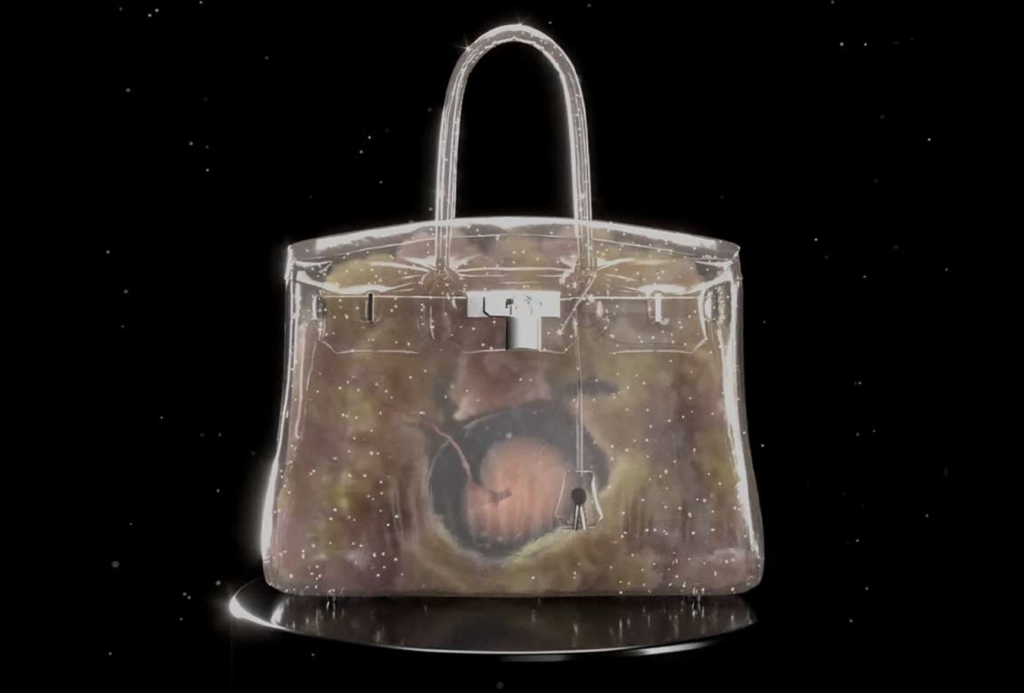A “Baby Birkin” bag is making headlines after selling for nearly $25,000 at an auction on members-only e-commerce platform Basic.Space. Unlike the bags that Hermès deals in, the small handbag – which is adorned with the design of a 40-week-old fetus – is not a leather good handcrafted by artisans in an Hermès-owned workshop. Instead, it is a non-fungible token (“NFT”) created by artists Mason Rothschild and Eric Ramirez, who offered up the 2000 x 2000 pixel animated NFT that they describe as “an ironic nod to the iconic Birkin Bag by Hermès.” And an unnamed individual took the bait, paying the crypto equivalent of $23,500 for the opportunity to own the “Baby Birkin.”
Hermès was, unsurprisingly, not involved in the NFT project in a hand-on capacity, and in all likelihood, the 184-year-old luxury brand also did not sign off on the use of its trademark-protected brand name or the “Birkin” moniker, which also serves as an indicator of source, thereby, marking it one of the latest instances of unauthorized use of fashion and luxury brands’ names and other assets in furtherance of the heavily-hyped NFT craze.
There is a chance that if faced with a trademark-centric lawsuit, Rothschild and Ramirez’s take on the famous handbag and their use of the Hermès and Birkin trademarks could be deemed fair use; no legal proceedings appear to be underway between Hermès and the Baby Birkin creators. However, the potential for conflict if noteworthy because it is representative of a larger trend that is seeing the rise of NFTs and digital fashion bring with them potential instances of infringement.
One need not look further than popular NFT auction platform Open Sea to observe the frequency with which NFT creators are looking to famous brands and their trademarks in a commercial capacity, often without authorization. From digital versions of things like the collaborative box logo that came by way of Louis Vuitton’s collaboration with Supreme to NFTs associated with physical luxury goods, such as a Louis Vuitton x Supreme backpack (which may or may not be authentic). As Orrick’s Sheryl Koval Garko, Mark Puzella, and Caroline Simons note, “Minting tools and NFT tutorials are now widely available on the internet, meaning that anyone could conceivably turn a file into an NFT.” The accessibility of the NFT-making market paired with the broader embrace of – and demand for – digital fashion items, particularly by Gen-Z consumers, has seemingly opened the door to those looking to trade on the well-established goodwill of famous fashion brands, and in the process, are presenting brands with an entirely new market to police when it comes to potential instances of infringement.
Reflecting on the array of budding legal issues in the digital space, Garko, Puzella, and Simons caution that “copying, selling, or publicly displaying works without authorization from the original creator (or the company that commissioned the work for hire) can: (1) constitute copyright infringement; (2) constitute trademark infringement, if consumers are confused about the source or sponsorship of the NFT; (3) infringe design patents, assuming substantially similarity; and/or (4) violate an individual’s right of publicity, if the NFT depicts individuals.”
In addition to potential IP infringement issues, unauthorized NFTs and virtual fashion offerings could create conflict from a right of publicity standpoint. Skadden attorneys Anthony Dreyer and David Lamb aptly assert that beyond the potential liability that exists for NFT-makers and auction platforms if/when an individual’s likeness is misappropriated, NFT purchasers need to be aware of possible pitfalls. “Purchasers of NFTs in which the underlying work violates a right of publicity risk liability not only if they attempt to resell the NFT, but also if they use the underlying work to promote their commercial interests (such as using their ownership of a valuable or desirable NFT to drive customers to their business).”
With the foregoing in mind, Garko, Puzella, and Simons state that NFT-minters and virtual fashion-makers should ensure that they have the requisite rights and permissions in the goods that they are creating, whether that be in copyright-protected imagery or trademark-protected names and logos, and that digital platforms “have policies in place to ensure the same and are prepared to respond to takedown requests to enjoy the protections afforded by the DMCA.”
Ultimately, while the enduring demand for NFTs and virtual fashion provides brands with “a great opportunity to build loyalty in their followers and customers, they should be vigilant about theft of their works and police conduct that could weaken or dilute their marks.” At the same time, brands would be wise to review their existing registrations in order to determine if the classifications of goods/services currently listed do not provide them with “enough coverage for NFTs” and digital fashion more broadly, and if they do not, they should seek to build new rights whenever possible. They also suggest that “design patents may be an additional way to protect high value designs, and add a layer of protection beyond consumer confusion.”














